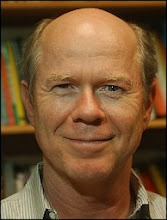Vicke Quinlyn’s interview with me part 1
Vicke Quinlyn interviewed me last year and I thought some readers might be interested in what we spoke of.
VQ: How did you get interested in neurofeedback?
DS: In 1983 I heard of Margaret Ayers in Beverly Hills doing neurofeedback. I knew nothing of it despite having written my doctoral dissertation on biofeedback. I had been referred a case of a 23 year old man who had injured his head while hang gliding. Immediately following the accident he began acting erratic. He had poor insight, was very impulsive, started abusing drugs, and was unable to work. He was dysfunctional in so many ways. Over the next 6 years he was hospitalized 6 times for psychiatric disturbances and was given a variety of diagnoses. Nobody knew what to do with him as neither medication nor psychotherapy helped. I finally referred him to Margaret Ayers for neurofeedback and he improved dramatically. He got off all medications. He returned to work in the family business. He got a girlfriend. He was never hospitalized again. Virtually all of his psychopathology disappeared. This led to my referring clients to Margaret Ayers for neurofeedback for the next 17 years. I saw the results and became a believer in the work. I posted details of this case on my website www.neurofeedback-sb.com.
VQ: When did you start practicing neurofeedback?
DS: I bought my first unit in 1990 after I took a 3 day seminar in the Peniston-Kulkosky alpha-theta training for alcoholism at the Menninger Clinic in Topeka, Kansas. The unit was rather crude, was limited to uptraining only two frequency bands, but worked just fine. I used it for a few years, but I had difficulty convincing clients to see me five times per week, which was the procedure at the time. In February 2001 I purchased the Neuropathways unit, the one Margaret Ayers holds a patent on. It was dramatically more powerful and more versatile that the one built by the Menninger Clinic. I began to use it for head injury, ADD, depression, and anxiety. Since then I have acquired a NeuroCarePro, a Roshi II+ with Bioexplorer software, a Neurointegrator with Bioexplorer software, and the Roshi II with the Amiga. I have lots of equipment.
VQ: Its common to find professionals like yourself having interests in science in their childhood. What experiences shaped your current interests?
DS: When I was 12 years old, I read a short article in the Encyclopedia on deep breathing as taught in the Eastern traditions. I was fascinated that such a simple process could produce such powerful results and was bewildered when I found that no adults I spoke to had the slightest knowledge of the subject. I taught myself how to control my breath and alter my state of consciousness. It proved valuable in playing sports as it improved my stamina and focus. It set the stage for my lifelong interest in self-regulation.
VQ: Did you major in psychology in college?
DS: I did major in psychology – good guess. I took every course available in the psychology department and carried a double minor in behavioral sciences and anthropology. I took my studies seriously and graduated with Great Distinction (3.96gpa). However, I was disappointed with my education. In the 1970’s courses in neuroscience lacked much substance. There was a basic lack of understanding of brain functioning at the time. I was disappointed that philosophy was the foundation of psychotherapy. As a college senior I envisioned a future where behavior change would come about far more rapidly and very differently than the 1970’s. I believed that once we knew more about the brain, psychologists would develop innovative strategies that were far different that what was being used at the time. I went on to earn my PhD in psychology. I never lost my interest in self-regulation and wrote my doctoral thesis on biofeedback.
VQ: Could you explain what biofeedback is?
DS: Biofeedback is the measurement of biological processes, amplifying them, and feeding it back to the body via the senses. As an example, one would have a difficult time guessing their hand temperature, but a special unit could tell you exactly, such as 78 degrees. By watching the gauge while its taped to the finger, a person can raise the temperature. This would normally be very difficult without the aid of visual or auditory feedback. Warming of the hands typically leaves a person feeling calm and relaxed as it reduces sympathetic nervous system activation and increases parasympathetic activity. In this state, the body is better able to allocate resources for repair and regeneration.
VQ: Is neurofeedback the same as biofeedback?
DS: The concepts are basically the same, only we are working with brainwaves. It’s sort of like the brain looking at itself in the mirror. Neurofeedback trains the brain to work more efficiently. When amplitudes are too high or the variation of the amplitude is too excessive, the brain is working too hard. Neurofeedback trains the brain to reduce the excessive power and stabilize the variations.
VQ: Do you still practice traditional psychotherapy?
DS: About half of my caseload is based on talk therapy. As you would expect, I often use technology to assist. While I use the traditional methods of cognitive behavior therapy, hypnosis, and EMDR, I often add audiovisual entrainment (AVE), electromedicine (Alpha-Stim SCS), and dietary supplements (5-HTP, OPC, etc.). These I have found to speed up results. I have specific protocols for cocaine, alcoholism, panic disorder, OCD, depression, and ADD.


0 Comments:
Post a Comment
<< Home